The AMD Radeon R9 380X Review, Feat. ASUS STRIX
by Ryan Smith on November 23, 2015 8:30 AM EST- Posted in
- GPUs
- AMD
- Radeon
- Asus
- Radeon 300
Power, Temperature, & Noise
As always, last but not least is our look at power, temperature, and noise. Next to price and performance of course, these are some of the most important aspects of a GPU, due in large part to the impact of noise. All things considered, a loud card is undesirable unless there’s a sufficiently good reason – or sufficiently good performance – to ignore the noise.
Unfortunately we don’t have any tools that can read the GPU voltage on the ASUS card, so we’ll jump right into average clockspeeds.
| Radeon R9 380X Average Clockspees | |||
| Game | ASUS R9 380X (OC) | ASUS R9 380X (Ref) | |
| Max Boost Clock | 1030MHz | 970MHz | |
| Battlefield 4 |
1030MHz
|
970MHz
|
|
| Crysis 3 |
1030MHz
|
970MHz
|
|
| Mordor |
1030MHz
|
970MHz
|
|
| Dragon Age |
1030MHz
|
970MHz
|
|
| Talos Principle |
1030MHz
|
970MHz
|
|
| Total War: Attila |
1030MHz
|
970MHz
|
|
| GRID Autosport |
1030MHz
|
970MHz
|
|
| Grand Theft Auto V |
1030MHz
|
970MHz
|
|
The ASUS R9 380X has no problem holding its full boost clockspeed in games, both at its stock speed of 1030MHz and when downclocked to 970MHz.
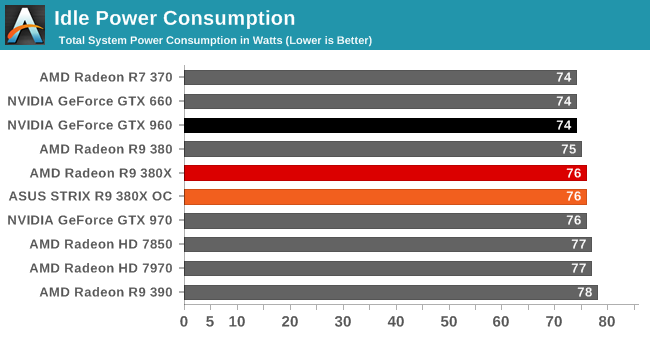
Starting with idle power consumption, the ASUS card comes in right where we’d expect it. 75-76W is typical for a Tonga card on our GPU testbed.

Moving on to power consumption under Crysis 3, like so many other aspects of R9 380X, its performance here is very close to the original R9 380. Power consumption is up slightly thanks to the additional CUs and the additional CPU load from the higher framerate, with the reference clocked R9 380X coming in at 299W, while ASUS’s factory overclock pushes that to 304W.
The problem for AMD is that this is smack-dab in GTX 970 territory. Meanwhile the GTX 960, though slightly slower, is drawing 74W less at the wall. R9 380 just wasn’t very competitive on power consumption compared to Maxwell, and R9 380X doesn’t do anything to change this. AMD’s power draw under games is essentially one class worse than NVIDIA’s – the R9 380X draws power like a GTX 970, but delivers performance only slightly ahead of a GTX 960.
The one bit of good news here for AMD is that while the power consumption of the R9 380X isn’t great, it’s still better balanced than the R9 390. With AMD opting to push the envelope there to maintain price/performance parity with the GTX 970, while the R9 380X is a fair bit slower than the R9 390, it saves a lot of power in the process. And for that matter the R9 380X shows a slight edge over the 7970, delivering similar gaming performance for around 16W less at the wall.
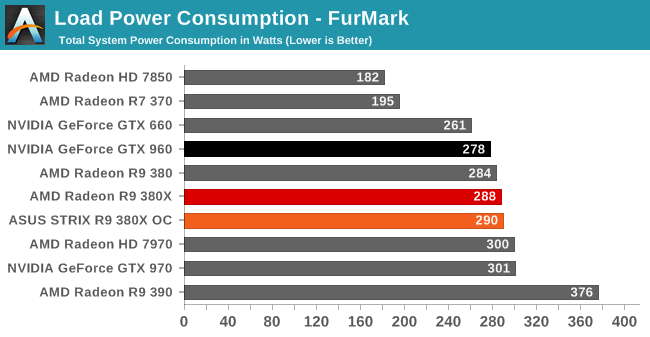
Moving over to FurMark our results get compressed by quite a bit (we’re using a GTX 960 with a fairly high power limit), but even then the R9 380X’s power consumption isn’t in AMD’s favor. At best we can say it’s between the GTX 960 and GTX 970, with the former offering performance not too far off for less power.
Otherwise as was the case with Crysis 3, the R9 380X holds a slight edge over the 7970 on power consumption. This despite the fact that the R9 380X uses AMD’s newer throttling technology, and consequently it gets closer to its true board limit than the 7970 ever did.
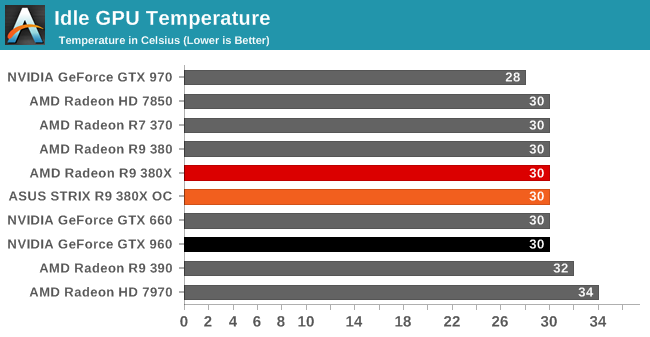
With idle temperatures ASUS’s 0db Fan technology doesn’t hamper the R9 380X at all. Even without any direct fan airflow the STRIX R9 380X holds at 30C.
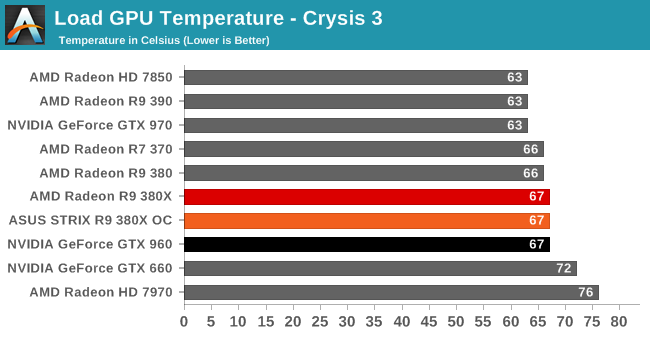
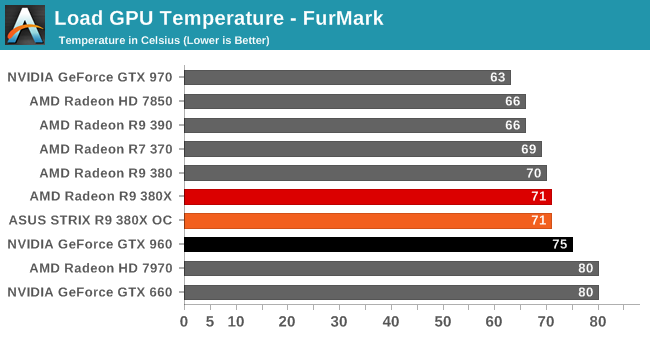
Load temperatures also look good. ASUS’s sweet spot seems to be around 70C – right where we like to see it for an open air cooled card – with the R9 380X reaching equilibrium at 67C for Crysis 3 and 71C for FurMark.
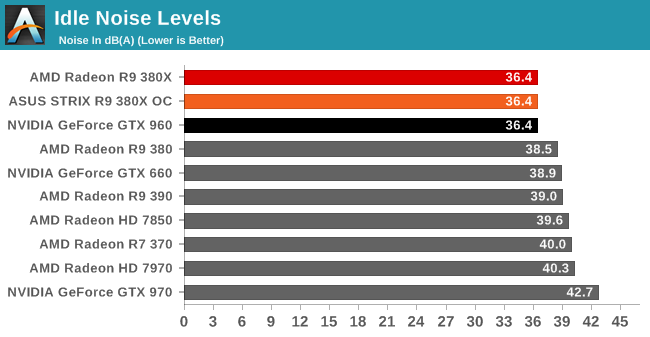
Finally with idle noise, the zero fan speed idle technology on the STRIX lineup means that the STRIX R9 380X gets top marks here. At 36.4dB the only noise coming from our system is closed loop liquid cooler for the CPU. The video card is completely silent.
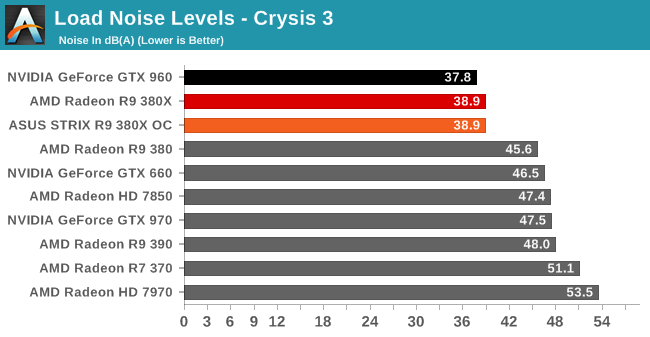
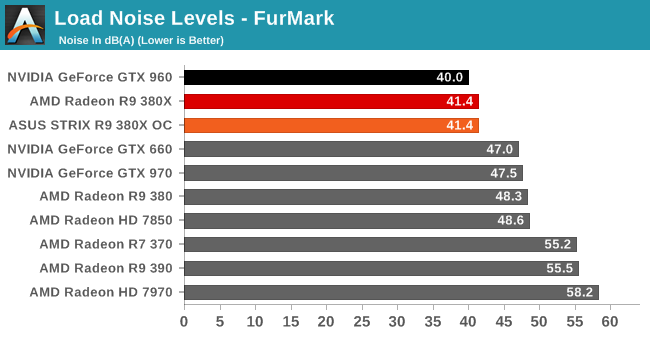
Shifting over to load noise levels then, the STRIX R9 380X continues to impress. With Crysis 3 the card tops out at 38.9dB – less then 3dB off of our noise floor – and that goes for both when the card is operating at AMD’s reference clocks and ASUS’s factory overclock. At this point the STRIX R9 380X is next-to-silent; it would be hard to do too much better without using an entirely passive cooling setup. So for ASUS to dissipate what we estimate to be 175W or so of heat while making this little noise is nothing short of impressive.
Meanwhile with FurMark the ASUS card needs to work a bit harder, but it still offers very good results. Even with the card maxed out we’re looking at just 41.4dB. The STRIX R9 380X isn’t silent, but it gets surprisingly close for such a powerful card.










101 Comments
View All Comments
Ryan Smith - Monday, November 23, 2015 - link
The power demands on the CPU are much more significant under a game than under FurMark.Also, that specific GTX 960 is an EVGA model with a ton of thermal/power headroom. So it's nowhere close to being TDP limited under Crysis.
Edit: My apologies to one of our posters. It looks like I managed to delete your post instead of replying to it...
The True Morbus - Monday, November 23, 2015 - link
So after all this time, this graphics card has the same performance as the now 2 years old GTX760?Right... I'm beginning to think the 760 was the best purchase of my life.
RussianSensation - Monday, November 23, 2015 - link
Same performance? You may need to re-check benchmarks across the web. R9 380X is more than 40% faster than a GTX760 2GB. TPU has it 43% faster at 1080P and 45% faster at 1440P:http://www.techpowerup.com/reviews/ASUS/R9_380X_St...
If you only have a 2GB version of the 760, you are also reducing texture quality in many games like Titanfall, Shadow of Mordor and have choppiness in Watch Dogs, AC Unity, Black Ops 3, and simply cannot even enable highest textures in some games like Wolfenstein NWO.
R9 380X isn't anything special when we've seen GTX970/290/290X/390 for $250-270 but it beats your card easily by 35-40%.
Laststop311 - Monday, November 23, 2015 - link
The 380x was a pointless launch. 50 dollars less you can just get the 380 which is only 10% slower. Or 50 more dollars and just get the 390 which blows the 380x away. This card targets a very narrow range and wasn't really needed imo.Makaveli - Monday, November 23, 2015 - link
I believe the difference in Shadow of Mordor between the 7970 and the 380x at 1080p may only be clockspeed and not a difference from Tahiti or Tonga!silverblue - Monday, November 23, 2015 - link
The 380X may come with extra features over the 7970, however has TrueAudio ever truly been tested? Its addition was to help reduce CPU usage and it would be a shame if it went unused in favour of the motherboard sound.silverblue - Monday, November 23, 2015 - link
Slight correction, it was to provide better effects, though I imagined that it would help a little with CPU usage anyway.Makaveli - Monday, November 23, 2015 - link
The only difference between them that counts is GCN 1.0 vs 1.2 TrueAudio has to be supported by the game and modor doesn't support it.Cryio - Monday, November 23, 2015 - link
You guys REALLY need to switch to a Skylake i7 4.5 GHz with DDR4 3000+ system for benching GPUs.That Ivy 4.2 GHz is certainly holding back AMD GPUs, core parking issues, not as fancy drivers and all.
Ryan Smith - Monday, November 23, 2015 - link
The GPU testbed is due for a refresh. We'll be upgrading to Broadwell-E in 2016 once that's available.